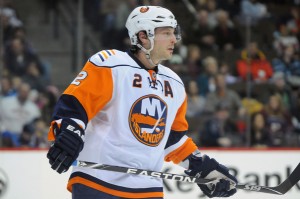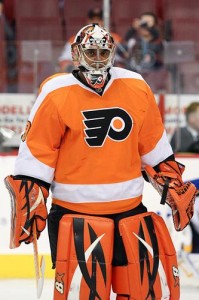
The way they ended their season — on a 6-1 run with three games of four or more goals — is exactly how the Philadelphia Flyers expect to start their new campaign in the 2013-14 season.
Many of the same faces are returning, but as always, reinforcements are on the way for the black and orange. After missing the postseason for just the second time since 1993, the Flyers are looking to get off to a good start, build momentum off of that and use that newly regained confidence to make a playoff push.
Will the top line be even better?
An already talented group a year ago, the Flyers went out and added All-Star Vinny Lecavalier; however, he will man the second line in the spot vacated by longtime fan favorite, Danny Briere.
Just as they did last season, the trio of Claude Giroux, Jake Voracek and Scott Hartnell will anchor the top group. Last year, Voracek took tremendous strides after earning a spot on the No. 1 line. With a year under his belt working alongside Giroux and Hartnell, there’s no reason Voracek shouldn’t be in for a banner year.
The captain of the team had a rather downer of a year in his first year of captaincy. He still is one of the most dangerous forwards in the league and he should return to his former self during the 82-game schedule. With Voracek blossoming into a star, Giroux will have more opportunities to get the looks he wants. He also could see time alongside Lecavalier once in a while during games, especially on powerplays, which should translate into even more production.
While Voracek and Giroux are the two key cogs for this team, the success of Hartnell may be the most pivotal for the effectiveness of their top line. Hartsy finished with just 11 points on eight goals during the lockout-shortened season and never was able to make his presence felt as he did during his 67-point season in 2011-12. At the age of 31, his days of 60-points may be behind him, but he still has a ton of talent and he must regain his form in order for the Flyers to be a serious contender.
Is This Brayden Schenn’s Breakout Year?
At 22, now is the time for Schenn to take the next step. This will be his third year in Philly and fifth in the NHL. At times last year, he showed signs of emerging into a star; unfortunately, he never was able to maintain those moments. With a full offseason under his belt, though, the odds of breaking out are heavy in his favor.
He developed chemistry with Wayne Simmonds and wound up finishing with a career-high 16 assists. The Flyers want to see him score more, though.
That’s where Lecavalier comes in.
One of the game’s best playmakers over the past decade, Lecavalier will center a line of Schenn and Simmonds, which should result in one of the most dangerous groups in the Eastern Conference. Schenn should see a lot of tape-to-tape passes coming his way, as well as plenty of openings to deliver the pass. All of this should equate into the type of season Philadelphia fans and NHL scouts have been expecting.

Is Mark Streit the answer on defense?
No, but he sure will help the unit out. The biggest reason the defense will be better is simply because they’re all healthy. Last season, Nicholas Grossman, Braydon Coburn, Andrej Meszaros all battled with injuries leaving guys like Oliver Lauridsen and Brandon Manning to fill in the voids.
As long as their top three pairings can stay intact, there will definitely be improvement from last year. The most important factor the unit’s success, though, lies on the shoulders of Luke Schenn. In his first year in Philadelphia, Schenn played well, posting a +3 plus/minus, but there is still plenty of room for growth in the 23-year old. If he can become a shutdown defenseman – as in someone who can win the battle on the boards, clear the puck and keep his man in front him – the Flyers’ defensive unit as a whole will perform much better than they did a year ago.
Reverting back to Mark Streit, his addition will be very impactful in two aspects: leadership and puck-moving ability. A former captain for the New York Islanders, Streit will bring experience and poise to the group, just as Timmonen does, and he’ll become the team’s top puck handler from the blue line. He will boost their powerplay because of his strong shot from the point and his presence on the man-advantage will create more opportunities for players around him due to his stick-handling.
After last season’s effort on defense, there’s only one way they can go: up.
How Will They Fare in the Division?
The newly aligned Metropolitan Division brings in new competition and three teams who are viable candidates to make a playoff push. The Washington Capitals have one of the best players in the world in Alex Ovechkin and a rising goaltender in Braden Holtby. As always, the Capitals should be in the mix for a playoff spot.
Meanwhile, teams like Carolina and Columbus both missed the playoffs last year but have enough talent on their roster to contend deep into the season. Those three additions will make things even harder for the Flyers.
Additionally, the likes of Pittsburgh and the New York Rangers will be jockeying for first place all season long with the emerging New York Islanders not far behind. There’s a good chance the New Jersey Devils could find themselves on the bottom of the division with the losses of Ilya Kovalchuk and David Clarkson, two of their top scorers. Although, the combination of Marty Brodeur and Corey Schneider, along with their defensive scheme, should make them a challenging team throughout the year. Finding someone to put the puck in the net will be their biggest obstacle.
On paper, the Penguins should be atop the Metropolitan followed by the Rangers. After that, a foreseeable battle between the Flyers, Islanders and Capitals seems likely. This should be a very cutthroat division as always despite the new name.

Is the Two-Goalie System Reliable?
It’s worked in the past with teams like St. Louis (Brian Elliot and Jaroslav Halak) and most recently, the Chicago Blackhawks (Corey Crawford and Ray Emery). Will it work in Philadelphia?
The addition of Emery, who played well over his expectations with a 17-1 record and 1.94 goals against average, definitely boosts their last line of defense. It’s not fair for Emery if fans are banking on him duplicating his statistics from the Blackhawks’ Stanley Cup run, but it is reasonable to expect production along the lines of 15-9 or 23-11, which were records he amassed when splitting time in 2011-12 and 2005-06, respectively.
If his performance at the end of last season is any indication, then Steve Mason should be in for a breakout season after taking a few steps backwards in Columbus following his Rookie of the Year campaign. He seems to have developed a valued connection with the team’s goalie coach so now that he has a whole offseason under his belt with Jeff Reese, he should be poised to excel in his first full season in Philadelphia.
When it comes to two-goalie systems, there is generally one goaltender who emerges. Last season, Emery watched Corey Crawford lead his team to the championship. Sitting on the bench and watching that happen after he did so well for the Blackhawks has to sting just a little bit. That should equal more motivation for Emery to want to separate himself from Mason. Between the two, Emery seems to be the most equipped to gain that No. 1 title down the stretch.
Final Prediction
The Flyers will wind up finishing third in the division behind the Penguins and Rangers but will have no trouble clinching a playoff spot with a 44-30-8 record. The Detroit Red Wings, not the Penguins, will be the No. 1 seed.